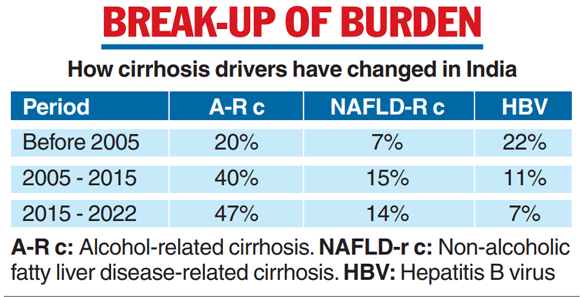Alcohol abuse and a largely hidden burden of non-alcoholic fatty liver disease (NAFLD) that remains generally unheeded by the public are the main causes of liver cirrhosis across India, a new study has established.
The study by doctors at the All India Institute of Medical Sciences, New Delhi, who analysed over 30 years of data has also suggested that NAFLD could explain many cases of what are often classified as unexplained or mystery cirrhosis.
They have found that alcohol accounted for 43 per cent and NAFLD accounted for 14 per cent of patients in a nationwide sample of 41,432 adults diagnosed with cirrhosis in hospitals across India since the mid-1990s.
“Alcohol is the top cause of cirrhosis in all five geographic regions,” said Shalimar, a professor in the gastroenterology department at AIIMS who led the study and uses a single name to identify himself.
The proportion of alcohol-linked cirrhosis was 56 per cent in the western zone, 50 per cent in the southern states, 47 per cent in central India, 42 per cent in the east, and 38 per cent in the northern states.
In the nationwide sample, chronic viral infections of the liver accounted for 16 per cent of cirrhosis — 11 per cent from the hepatitis B virus (HBV) and 6 per cent from the hepatitis C virus (HCV). The other causes were auto-immune disorders in which the immune system attacks liver cells and certain genetic disorders.
“The trends over time are clear — we see a rise in both alcohol-related and NAFLD-related cirrhosis and a decrease in cirrhosis from viral hepatitis,” Shalimar said. “Our analysis corroborates the evidence from earlier studies based on smaller samples.”
Alcohol-related cirrhosis has increased from 20 per cent before 2005 to around 40 per cent between 2005-2015 and to 47 per cent between 2015-2022. This rise has occurred alongside an increase in India’s estimated per capita alcohol consumption — from 2.3 litres in the year 2000 to 5.5 litres in 2018, according to figures cited by the World Health Organisation in 2020.
Doctors tracking alcohol abuse in the country have in the past expressed concern that much of the rise in the per capita alcohol consumption is driven both by a nationwide increase as well as binge drinking behaviour prevalent in India.
Shalimar and his colleagues pooled data from 158 earlier studies to conduct what medical researchers call a “meta-analysis” — an exercise designed to draw reliable inferences by overcoming the limitations posed by small sample sizes of the earlier individual studies. Their findings were published this week in the Journal of Clinical and Experimental Hepatology.
The researchers believe the contribution of NAFLD to cirrhosis is likely to rise in the coming years amid signals that over a third of adults in the country have NAFLD, a condition brought out by fat-laden foods and sedentary lifestyle.
“Many people are likely unaware they have NAFLD,” said Shalimar. A similar meta-analysis of NAFLD conducted by the AIIMS team last year had found that nearly 39 per cent of adults in the country have NAFLD.
These findings underline the need for a clear policy to tackle alcohol abuse and NAFLD, said Abhijit Chowdhury, a hepatologist at the Institute of Liver and Digestive Sciences, Calcutta, who was not associated with the AIIMS study but has also studied chronic liver disease patterns in India.
“One option would be higher taxes — financial disincentives against alcohol, but we’re not seeing that happening,” Chowdhury said. “Nearly all the states get revenue from alcohol taxes and we don’t see any real disincentives yet.”











